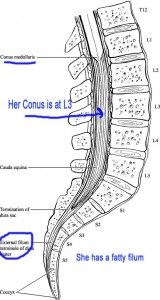When the spinal cord is not free to move in the spinal canal, tension on the cord can damage nerves that may result in loss of bladder control, problems with walking, sensory changes, and orthopedic problems including foot deformities and scoliosis (Hertzler et al. 2010, Liu et al. 2011). There are multiple causes of tethered cord syndrome (TCS), and the symptoms are varied and involve multiple systems (Hertzler et al. 2010, Liu et al. 2011). Sometimes TCS is recognized by the presence of external signs including lesions, hairy patches, deep dimples or fatty tumors; however, it’s not always identified until a child is older and starts to exhibit problems with bladder control, walking or other neurosensory issues during growth spurts (Hertzler et al. 2010, NINDS).
TCS is diagnosed via MRI and evaluation of symptoms. The position of the conus medullaris below the L1 vertebrae, presence of a fatty tumor (fibrolipoma), and thickness of the filum terminale are associated with a tethered cord. It is not always possible to see the actual tethering via the MRI (my understanding). In addition to an MRI, urodynamic studies can be helpful in making a diagnosis. A Cystometry (CMG) study evaluates the capacity of the bladder and how well the sensory input is working. The nerves at the base of the spinal cord innervate the bladder, so when there is a lot of tension in the cord, problems with continence can develop. TCS can be treated via surgery (de-tethering), and the prognosis is good!
http://www.emedicinehealth.com/cauda_equina_syndrome/page15_em.htm
Sources:
Hertzler et al. 2010. Tethered cord syndrome: a review of the literature from embryology to adult presentation. Neurosurg Focus 29(1):E1.
Life Tech International. 2011. Clinical application notes: Introduction to Urodynamics III: Urodynamic procedures, CMG. http://www.life-tech.com/uro/urolib/cystometry.shtml accessed 24 April 2012.
Liu et al. 2011. SEM tudy on filum terminale with tethered cord syndrome. Childs Nerv Syst 27:2141-2144.
NINDS. 2011. NINDS tethered spinal cord syndromw information page. http://www.ninds.nih.gov/disorders/tethered_cord/tethered_cord.htm accessed 24 April 2012.


Praying for resolution and direction for you and the docs.